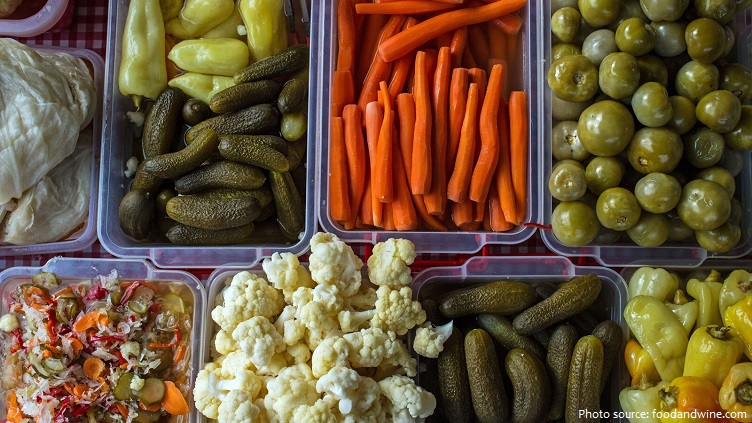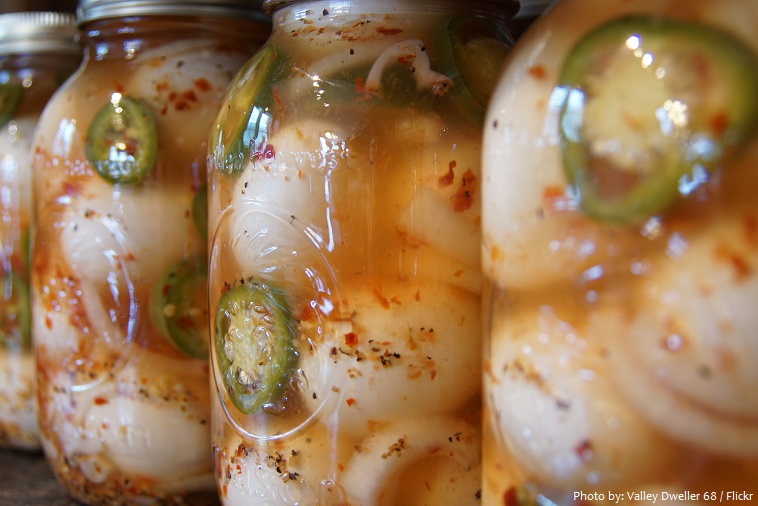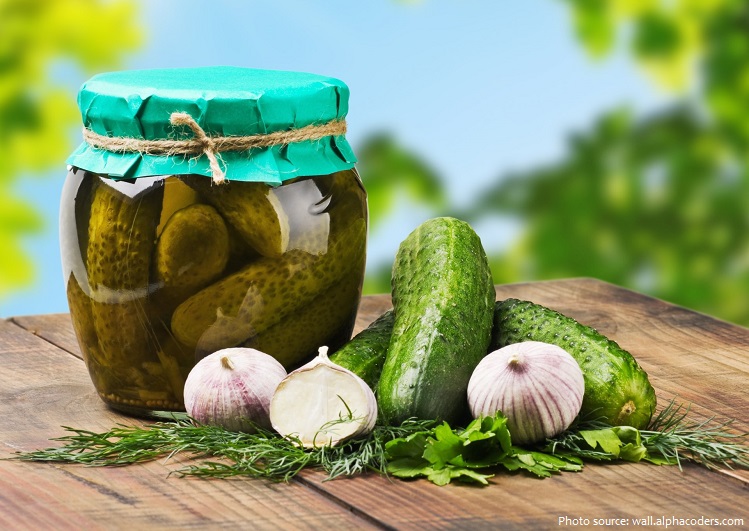
Pickling is the process of preserving or extending the shelf life of food by either anaerobic fermentation in brine or immersion in vinegar.
The pickling procedure typically affects the food’s texture and flavor. The resulting food is called a pickle, or, to prevent ambiguity, prefaced with pickled. Foods that are pickled include vegetables, fruits, meats, fish, dairy and eggs.
The key to pickling is that it produces low pH, 4.5 or lower. This kills most bacteria. Pickling can preserve perishable foods for months. Anti-microbial herbs and spices, such as mustard seed, garlic, cinnamon or cloves, are often added.

Pickled vegetables are low in calories. They also contain a small amount of calcium, potassium, magnesium, vitamin C and Kvitamin K.
The term “pickle” is derived from the Dutch word pekel, meaning brine.
In the United States and Canada, the word “pickle” alone almost always refers to a pickled cucumber, however plenty of other vegetables, like green beans also make a delicious pickle. It is not uncommon to see pickled
onions, cabbage (think sauerkraut) and cauliflower. Giardiniera, a mixture of pickled peppers, celery and olives, is a popular condiment with Italian-American populations.
In the UK, “pickle” (as in a “cheese and pickle sandwich“) may also refer to Ploughman’s pickle, which is a kind of chutney.

The term commonly used in British English to refer to a pickled cucumber, gherkin, is also of Dutch origin, derived from the word gurken or augurken, meaning cucumber.
Pickling — preserving foods in vinegar, brine or a similar solution — is one of the oldest methods of food preservation. Though the exact origins of the process are unknown, archaeologists believe ancient Mesopotamians pickled food as far back as 2400 BC, according to the New York Food Museum. Several centuries later, cucumbers native to India were being pickled in the Tigris Valley.
Aristotle is reported to have praised pickled cucumbers, around 850 BC, for their healing effects.
Legendary Egyptian queen Cleopatra was known for her love of pickles. She even believed they contributed to her health and her beauty, which was so revered that it has persisted through the years. Philosopher Aristotle even echoed the queen’s belief that pickles were essential to a person’s vitality.

Cleopatra’s lover Julius Caesar and other Roman emperors gave pickles to their troops to eat in the belief that they would make them strong.
While people were probably pickling and preserving foods in vinegar and other spices, the emergence of dill in Europe in the late stages of the first millennium was a total game-changer. Right around the year 900 AD, new trade routes from the East emerged, allowing things like spices, textiles, and herbs to permeate Europe.
During the Age of Exploration, many sailors on transoceanic voyages suffered from scurvy, a nasty but all-too-common disease caused by a deficiency of Vitamin C. On his storied expedition to the New World,
Christopher Columbus reportedly rationed pickles to his sailors, even going so far as to grow cucumbers in Haiti to restock for the rest of the trip. And that’s not all: Before he was an explorer, Amerigo Vespucci worked as a ship’s chandler in Seville, Spain—meaning he supplied ships with goods like preserved meat and vegetables. Known as the “Pickle-Dealer,” Vespucci even helped stock Columbus’s ships on his later, less successful voyages across the Atlantic.

Napoleon also valued pickles as a health asset for his armies, so much so that he offered the equivalent of $250,000 to anyone who could develop a way to preserve food safely. The man who won the prize in 1809 was a confectioner named Nicholas Appert, who figured out that if you removed the air from a bottle and boiled it, the food wouldn’t spoil. He’d have to wait for Pasteur to describe why by making the bottle airtight, no microorganisms could enter, and by boiling it, any microorganisms that existed were killed. Known today as the “boiling water bath,” Appert’s discovery was one of the most influential culinary contributions in history.
Pickling eggs was de rigeur in England as far back as the 1830s, when a public house known as the Pickled Egg (on—where else?—London’s Pickled Egg Lane) was supposedly the place to be.

Americans favored pickled eggs in their dive bars and taverns. A jar of pickled eggs was one of the foolproof signs that you are, in fact, in a dive bar. One of the first documented mentions of pickled eggs in America appeared in “The Kentucky Housewife” in 1839. There, Lettice Bryan shared a recipe that included nutmeg and cloves, and even suggested cutting them into ringlets.
When a heavy influx of eastern European Jews arrived in New York City during the late 1800s and early 1900s, immigrants introduced kosher dill pickles to America. Cucumbers were washed, then piled in large wooden barrels along with dill, garlic, spices, kosher salt and clean water. They were left to ferment for a few weeks to several months – shorter fermenting time produced brighter green half sours, while longer fermentation resulted in full sours. Pickles were sold on pushcarts in the immigrant tenement district of New York City. Over time, Jewish-owned shops selling pickles straight out of the barrel began appearing in droves. Eventually, pickling became a profitable business within the Jewish community. Today, a plate of pickles is usually served complimentary with a meal at the best Jewish delis.

Pickling at home became safer and more accessible in the mid-19th century with the invention of two key canning tools. James Young from Scotland created paraffin wax, which made a wonderful seal to lock in the freshness of pickles. Not long after, John Mason introduced his Mason jar, which is still used to this day and serves as a terrific vehicle for paraffin wax to work most effectively.
Finally, at the turn of the 20th century, H.J. Heinz became the undisputed pickle king when he took the demand for pickles and combined it with modern canning technology. Heinz used the glass jar technology of John Mason, whose “Mason Jar” sealed food thanks to a paraffin wax seal. Heinz caned and distributed pickles throughout the united states using the classic kosher dill recipe perfected over thousands of years by humankind.